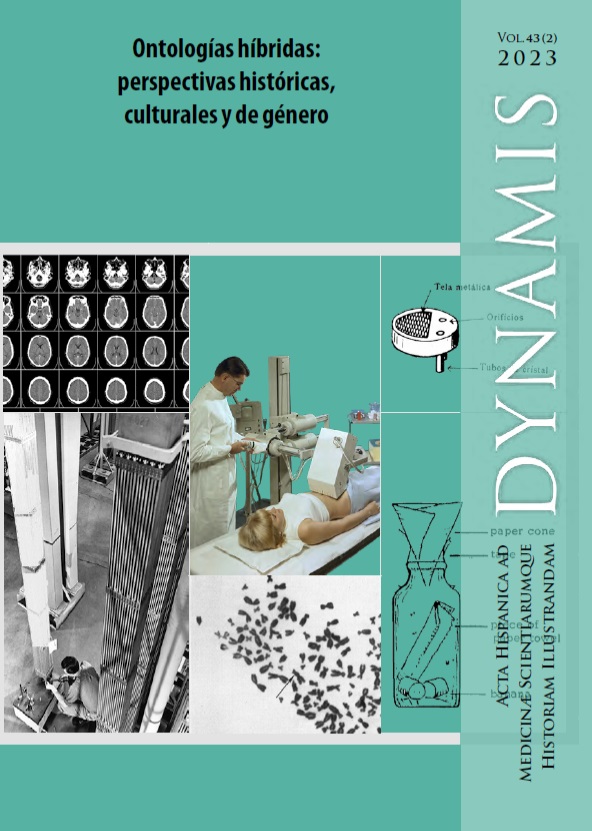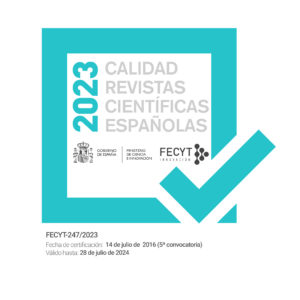Hypnotizing women, between the femme fatale and the witch in Arthur Conan Doyle’s literary fiction
DOI:
https://doi.org/10.30827/dynamis.v43i2.29448Keywords:
woman hypnotist; Conan Doyle; femme fatale; witch; hypnotic fictionAbstract
The historiography on mesmerism and hypnosis shows that there were few women who put this knowledge into practice. In this sense, it is significant that there are few images of a woman hypnotizing a man and no images of a woman hypnotizing another woman. Thus, the woman who hypnotizes a man becomes a revolutionary, a subversive case that turns around not only a classic hypnotic relationship but also a social and historical situation of clear patriarchal domination. In this paper, I analyze two stories by Arthur Conan Doyle (1859-1930) featuring female hypnotists: John Barrington Cowles (1884) and The Parasite (1894). In the case of John Barrington Cowles, the hypnotizing woman is based on the literary and filmic stereotype of the femme fatale, which will appear in many different narrative formats throughout the 20th century up to the present day. In the case of The Parasite, however, the hypnotizing woman is much closer to the literary and folkloric stereotype of the witch. In this sense, I point out the fundamental role that the stereotype of the hypnotizing woman has played in recent cultural gender studies.
Downloads
References
Alexandrian. Historia de la filosofía oculta. Madrid: Valdemar, 2014.
Allan-Poe, Edgar. “Los hechos en el caso del señor Valdemar,” in Relatos, 364-375. Madrid: Catedra, 2002.
Anonymous. “Mrs. Mary Baker Eddy’s: Case of Histeria.” Journal of the American Medical Association 7 (1907): 614-615. DOI: https://doi.org/10.1001/jama.1907.02520330056007
Barstow, Anne. Witchcraze: A New History of the European Witch Hunts, our Legacy of Violence Against Women. New York: Pandora Harper Collins, 1994.
Beaunis, Henri. El sonambulismo provocado: Estudios fisiológicos y psicológicos. Madrid: Bailly-Baillière, 1888.
Bloom, Harold. La religión en los Estados Unidos: el surgimiento de la nación poscristiana. México: Fondo de Cultura Económica, 1994.
Braun, Heather. The Rise and Fall of the Femme Fatale in British literature, 1790-1910. Madison: Fairleigh Dickinson University Press, 2012.
Buff, Teri. Mesmerism and Women in Late Victorian Popular Fiction with Particular Emphasis on the Femme Fatale 1885-1905. Oxford: Oxford University Press, 1998.
Burton, Robert. Anatomía de la melancolía. Madrid: Alianza Editorial, 2006.
Caamaño, Eduardo. Arthur Conan Doyle. Córdoba: Almuzara, 2018.
Caro-Baroja, Julio. Las brujas y su mundo. Un estudio antropológico de la sociedad en una época oscura. Madrid: Alianza editorial, 1993.
Chaves, José. “Magia y ocultismo en el siglo XIX,” in De filósofos, magos y brujas, 247-277. Barcelona: Azul, 1999.
Chertok, Leon. La hipnosis. Madrid: Atika, 1964.
Chollet, Mona. Brujas ¿Estigma o la fuerza invisible de las mujeres? Barcelona: Penguin Random House, 2019.
Conan-Doyle, Arthur. Memorias y aventuras. Madrid: Valdemar, 2015.
Conan Doyle, Arthur. “John Barrington Cowles,” in El parásito y otros cuentos de terror, 119-142. Madrid: Valdemar, 2020.
Arthur Conan-Doyle, Arthur. “El parásito,” in El parásito y otros cuentos de terror, 361-414. Madrid: Valdemar, 2020.
Costello, Peter. Conan Doyle, detective. Los crímenes reales que investigo el creador de Sherlock Holmes. Barcelona: Alba, 2008.
Crenshaw, Kimberlé. “Demarginalizing the Intersection of Race and Sex: A Black Feminist Critique of Antidiscrimination Doctrine, Feminist Theory and Antiracist Politics.” University of Chicago Legal Forum 1 (1989): 139-150.
Federici, Silvia. Caliban y la bruja. Mujeres, cuerpo y acumulación originaria. Madrid: Traficantes de Sueños, 2010.
Fox, Margarita. Arthur Conan Doyle, investigador privado. Madrid: Tusquets, 2020.
Gauld, Alan. A History of Hypnotism. New York: Cambridge University Press, 1992.
Gleadle, Kathryn. British Women in the Nineteenth Century. New York: Palgrave, 2001. DOI: https://doi.org/10.1007/978-1-4039-3754-4
Green, Christopher. Overpowered! The Science and Showbiz of Hipnosis. London: The British Library, 2015.
Haraway, Donna. Ciencia, ciborgs y mujeres. La reinvención de la naturaleza. Madrid: Catedra, 1991.
Hollis, Patricia. Women in Public: Women’s Movement 1850-1900. London: Allen&Unwin, 1981.
Hormigos, Montserrat and Carlos Cuéllar (eds.). La bruja. Una figura fascinante. Valencia: Shangrila, 2022.
Hutton, Ronald. The Witch: A History of Fear from Ancient Times to the Present. London: Yale University Press, 2017. DOI: https://doi.org/10.2307/j.ctv1bzfpmr
Karlsen, Carol. The Devil in the Shape of a Woman: Witchcraft in Colonial New England. New York: Vintage Books, 1989.
Knight, Stephen. “The Case of the Great Detective.” Meanjin 40, no. 2 (1981): 175-185.
Lagarde, Marcela. Los cautiverios de las mujeres. Madresposas, monjas, putas, presas y locas. Madrid: horas y HORAS, 2011.
Larner, Christina. Enemies of God: The Witch-Hunt in Scotland. Baltimore: Johns Hopkins University Press, 1981.
Ledger, Sally. The New Woman. Fiction and Feminism at the Fin de Siècle. Manchester: Manchester University Press, 1997.
Légère, Julie; Whyte, Elsa and Laura Pérez. Los secretos de las brujas. Madrid: Errata Naturae, 2020.
Lehman, Amy. Victorian Women and the Theatre of Trance: Mediums, Spiritualists and Mesmerists in Performance. Jefferson: McFarland and Company, 2009.
López-Piñero, José María and José María Morales. Neurosis y psicoterapia. Un estudio histórico. Madrid: Espasa-Calpe, 1970.
López-Piñero, José María. Del hipnotismo a Freud. Orígenes históricos de la psicoterapia. Madrid: Alianza Editorial, 2002.
Maxwell, Catherine. The Female Sublime from Milton to Swinburne. Bearing Blindness. Manchester: Manchester University Press, 2001.
Michelet, Jules. La bruja. Un estudio de las supersticiones en la Edad Media. Madrid: Akal, 2002.
Montiel, Luis. Daemoniaca. Curación mágica, posesión y profecía en el marco del magnetismo animal romántico. Barcelona: MRA, 2006.
Montiel, Luis. Magnetizadores y sonámbulas en la Alemania romántica. Madrid: Frenia, 2008.
Morales, Grace (ed.). Mágicas. Brujas, magas y sacerdotisas del amor. España: La Felguera, 2022.
Morgan, Robin. Sisterhood is Powerful. New York: Vintage, 1970.
Nordon, Pierre. Conan Doyle: A Biography. London: Holt, 1996.
Owen, Alex. The Darkened Room: Women, Power, and Spiritualism in Late Victorian England. Philadelphia: University of Pennsylvania Press, 1999.
Paglia, Camille. Sexual Personae. Madrid: Valdemar, 2006.
Sims, Michael. Arthur y Sherlock. Conan Doyle y la creación de Holmes. Barcelona: Alpha Decay, 2018.
Smith-Rosenberg Carroll. “The Hysterical Woman: Sex Roles and Role Conflict in 19thcentury America.” Social Research 39, n.º 4 (1972): 652-678.
Starhawk. Dreaming the Dark: Magic, Sex, and Politics. Boston: Beacon Press, 1982.
Stavert, Geoffrey. A Study in Southsea: The Unrevealed Life of Doctor Arthur Conan Doyle. Portsmouth: Milestone Publications, 1987.
Steinbach, Susie. Women in England 1760-1914. A Social History. London: Phoenix, 2005.
Stratton, Kimberly and Dayna Kalleres (eds.). Daughters of Hecate: Women and Magic in the Ancient World. Oxford: Oxford University Press, 2014. DOI: https://doi.org/10.1093/acprof:oso/9780195342703.001.0001
Winter, Alison. Mesmerized: powers of mind in Victorian Britain. Chicago and London: The University of Chicago Press, 1998.
Wolffram, Heather. The Stepchildren of Science: Psychical Research and Parapsychology in Germany, c. 1870-1939. Amsterdam: Rodopi, 2009. DOI: https://doi.org/10.1163/9789042027299
Zweig, Stefan. La curación por el espíritu: Mesmer, Mary Baker-Eddy, Freud. Barcelona: Acantilado, 2006.
Downloads
Published
How to Cite
Issue
Section
License
Copyright (c) 2023 Dynamis

This work is licensed under a Creative Commons Attribution-NonCommercial-NoDerivatives 4.0 International License.
Dynamis se encuentra adherida a una licencia Creative Commons Reconocimiento (by), la cual permite cualquier explotación de la obra, incluyendo una finalidad comercial, así como la creación de obras derivadas, la distribución de las cuales también está permitida sin ninguna restricción.

















